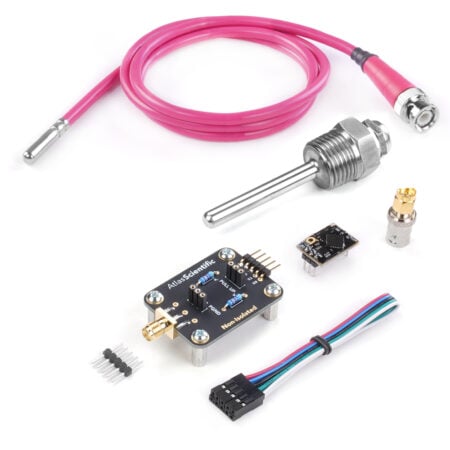

Best pH Probes For Hydroponics in 2025 – A Complete Buying Guide
Finding the best pH probe for hydroponics can make or break your growing success. In hydroponics, maintaining the correct pH is essential because it directly
# Type at least 1 character to search # Hit enter to search or ESC to close

No products in the cart.

No products in the cart.
Product Categories

Fermentation is a crucial process in the production of our favorite drinks, like beer and wine, as well as various food products like bread and yogurt. Temperature plays a significant role in the success of fermentation, influencing the behavior of the microorganisms responsible for this chemical transformation.
Fermentation is a metabolic process that occurs in microorganisms like yeast and bacteria. These organisms convert sugars and other organic compounds into simpler substances, such as alcohol and carbon dioxide, through a series of chemical reactions.
The success and efficiency of these reactions largely depend on various factors, including the temperature at which the process takes place.
Yeast, a type of single-celled fungi, is a vital component in the fermentation process, particularly in brewing beer and making bread.
Yeast cells consume sugar and produce alcohol and carbon dioxide as by-products, giving rise to the characteristic taste, texture, and aroma of fermented products.

However, yeast is sensitive to temperature changes and can exhibit different behaviors under different temperature conditions.
Temperature is a critical factor that dictates the speed and efficiency of fermentation. While there is no single “optimal” temperature for all fermentation processes, the ideal temperature depends on the specific recipe and type of microorganism involved.
However, certain general trends can be observed across various fermentation processes, which can help us understand how temperature influences the process.

For the two most popular classes of beers (ales and lagers), the ideal fermentation temperature ranges are:
It’s important to note that these temperature ranges are not set in stone and may vary depending on the specific recipe or yeast strain used.
Yeast is highly sensitive to temperature fluctuations, and its activity levels can be directly affected by changes in the surrounding environment. As previously mentioned, yeast can become overworked or lethargic depending on the temperature.

In general, the rate of fermentation increases with temperature, leading to more efficient conversion of sugars and the production of more by-products. However, this increase in fermentation rate is not always desirable, as it can lead to the formation of off-flavors and other undesirable characteristics in the final product.
Temperature control is an essential aspect of the fermentation process. Maintaining the ideal temperature for a specific yeast strain or recipe ensures that the desired flavor, aroma, and texture profiles are achieved. In addition, proper temperature control can help prevent the growth of undesirable organisms and reduce the risk of spoilage.
To achieve accurate temperature control, it is recommended to invest in a high-quality thermometer and regularly calibrate it using a 50/50 ice water solution at 32°F (0°C).
Although air temperature doesn’t have a direct impact on the temperature of the fermentation medium (such as wort in beer brewing), it can indirectly influence the process through convective heat exchange. Air temperature can act as a heat sink or source, depending on the conditions, and can potentially cause fluctuations in fermentation temperature.
Cold weather can slow down the fermentation process, as it tends to reduce the activity of yeast cells. This phenomenon is particularly evident in the production of lagers, which have evolved to ferment at lower temperatures due to their origins in colder climates. In cold conditions, yeast cells can clump together and fall out of suspension, reducing their contact with sugars and slowing down the conversion process. However, the specific temperature at which this effect occurs can vary depending on the yeast strain used.

Cold fermentation is typically used in the production of lagers, as it helps to minimize the production of esters and phenols, which can contribute to fruity, citrusy, or smoky flavors in beer. This type of fermentation is characterized by lower temperatures, usually in the range of 48 to 58°F (9 to 15°C), and results in a smooth, clean, and crisp final product.

Warm fermentation, on the other hand, is commonly employed in the production of ales and involves higher temperatures, typically between 68 and 72°F (20 to 22°C). This type of fermentation allows for the production of more complex flavors and aromas, as the yeast generates a greater variety of by-products. The resulting beer has a more pronounced flavor profile, influenced by both the ingredients and the yeast’s activity.
Temperature also plays a significant role in the fermentation of bread dough, which relies on the activity of yeast to produce carbon dioxide and cause the dough to rise. The optimal temperature for bread fermentation is typically between 85 and 90°F (29-32°C), as this temperature promotes the highest rate of carbon dioxide production and, consequently, the most effective dough rise. Higher or lower temperatures can result in less efficient fermentation and may negatively impact the final bread’s texture and taste.

Temperature can also impact other fermentation processes, such as the production of yogurt, cheese, and various fermented vegetables.
In general, the principles discussed above regarding yeast fermentation apply to these other processes, with temperature playing a crucial role in determining the activity of the microorganisms responsible for fermentation. Maintaining the optimal temperature during these processes helps ensure that the desired flavors, textures, and nutritional qualities are achieved.

It is possible to increase the fermentation temperature during the process to optimize the activity of the yeast strain and potentially improve the final product’s flavor and aroma.
One approach involves starting at a slightly lower temperature than the ideal range and gradually increasing it over time. This method can be particularly useful in environments with significant temperature fluctuations or when using yeast strains with specific temperature preferences.
A common strategy for increasing fermentation temperature involves starting at a relatively cooler temperature than the target ideal and slowly warming up after the onset of active fermentation (typically three days after pitching the yeast). To implement this method:

This method can help ensure that the yeast remains active and efficient throughout the fermentation process while minimizing the risk of off-flavors or other undesirable characteristics.
As previously discussed, the rate of fermentation increases with temperature, leading to more efficient sugar conversion and greater production of by-products. This increased activity can be beneficial in some cases, but it may also result in the formation of off-flavors or other issues if not carefully managed.
The increase in fermentation rate with temperature is primarily due to the increased activity of the enzymes responsible for converting sugar into alcohol. These enzymes work within specific temperature ranges and can become less efficient or even non-functional if the temperature becomes too high.

Additionally, yeast reproduction rates increase with temperature, allowing for a greater number of active cells to participate in the fermentation process.
Fermentation is an exothermic process, meaning that it generates heat as a by-product of the chemical reactions taking place. This heat can cause the fermentation temperature to rise, potentially leading to temperature fluctuations and potentially impacting the efficiency of the process and introducing unwanted flavors.
To minimize the impact of heat generation during fermentation, it is crucial to maintain a stable temperature throughout the process. This can be achieved through the use of temperature-controlled fermentation vessels or by placing the fermenter in a temperature-controlled environment, such as a cellar or an air-conditioned room.

The most reliable way to constantly monitor the temperature during fermentation is with a temperature sensor. Temperature sensors are fantastic at detecting the exact temperature during the fermentation process.
Temperature plays a critical role in the fermentation process, influencing the activity of yeast and other microorganisms and ultimately determining the flavor, aroma, and texture of the final product. By understanding the relationship between temperature and fermentation and implementing effective temperature control strategies, it is possible to optimize the process and produce consistently high-quality fermented products.

If you have any questions regarding fermentation or how to accurately measure the temperature, do not hesitate to contact the world-class team at Atlas Scientific.







Finding the best pH probe for hydroponics can make or break your growing success. In hydroponics, maintaining the correct pH is essential because it directly

The fastest way to reduce ammonia levels in a fish tank is to perform partial water changes, temporarily stop feeding fish, use chemical filtration, increase